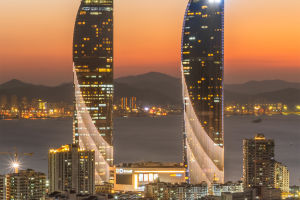When the sun sets and night slowly falls, the city transforms, coming alive with a different kind of vitality.
The bustling, prosperous cityscape of the day shifts into a shimmering realm of neon lights and shadows, creating a dreamy world of illumination.
At night, the city is more than just an interplay of light and shadow; it becomes a carnival that captivates countless individuals who immerse themselves in its vibrant energy.
City Landscape: An Interplay of Light and Shadow
As night descends, the city's skyline ignites with a constellation of lights. High-rise buildings adorned with light shows, neon shop signs, and impromptu street performances come together to paint a dynamic and vibrant picture.
In Shanghai's Bund, the bright lights on both sides of the Huangpu River reflect the modern city's prosperity and splendor. Similarly, New York's Times Square dazzles with its myriad electronic screens flashing advertisements and information, crafting a futuristic atmosphere.
These dynamic displays of light and shadow do more than decorate the city's exterior; they imbue it with a unique cultural essence. In Hong Kong, the annual Victoria Harbor Light Show draws thousands of spectators.
Here, colorful laser beams synchronize with the rhythm of music, delivering an audiovisual feast. Light and shadow have thus become integral to urban culture, narrating stories of the city’s history, present, and future.
Nighttime Festivities: The City's Carnival
The city at night is not only a visual spectacle but also a stage for communal revelry. Night markets, clubs, and a plethora of open-air activities add an endless allure to the nocturnal cityscape.
In bustling night markets, people savor culinary delights from around the world, experiencing the rich tapestry of local culture. Meanwhile, in clubs, music and dance provide an escape from the day's weariness, allowing people to indulge in the joys of nightlife.
Under the neon glow, young people converge in various entertainment venues to revel in the fusion of music, dance, and camaraderie.
Berlin's nightlife, known for its openness and inclusivity, features numerous underground clubs and music festivals that attract nightlife enthusiasts globally. Regardless of location, nighttime festivities in cities pulse with energy and passion, offering an electrifying experience.
The Night Economy: A Catalyst for Urban Development
With the myriad of nighttime activities, the night economy has emerged as a crucial component of urban growth. Night markets, 24-hour convenience stores, and nocturnal tourism projects cater to the needs of both residents and tourists, simultaneously driving related industries' development.
The city's nighttime vitality not only enhances residents' quality of life but also injects fresh momentum into economic growth.
In Guangzhou, for instance, night markets and food streets attract a vast number of tourists, significantly benefiting the local economy. Beijing's nighttime economy spans culture, entertainment, and catering, from alleyway taverns to large-scale music festivals, showcasing the city's unique charm.
The rise of the nighttime economy signifies more than just increased consumption; it reflects the diversity and richness of urban culture.
Technology Enhancing the Night: The Fusion of Light, Shadow, and Innovation
Modern technology has made urban nighttime festivities more thrilling. Advanced technologies such as projection mapping, laser shows, and 3D holographic projections are now common in city nightscapes. These technological marvels enrich the expressions of light and shadow, producing more awe-inspiring effects.
In Dubai, the annual Festival of Lights leverages cutting-edge light and shadow technology to transform buildings, streets, and squares into expansive art canvases.
Similarly, the Paris Light Festival captivates with artists using lights and images to narrate the city's historical saga. Technology enhances the expressiveness of light and shadow and infuses the nocturnal city with a sense of fantasy and magic.
Conclusion
The city at night is akin to a feast of light and shadow, showcasing its unique charm through spectacular illuminations and colorful activities.
The urban landscape, intertwined with lights and shadows, nighttime revelries, the thriving night economy, and the seamless integration of technology with light and shadow together create an unforgettable nocturnal world.
This festival of light and shadow offers more than just visual and sensory delights; it symbolizes urban culture and vitality. Both residents and international visitors will find joy and inspiration in this nocturnal celebration of light, shadow, and carnival.


